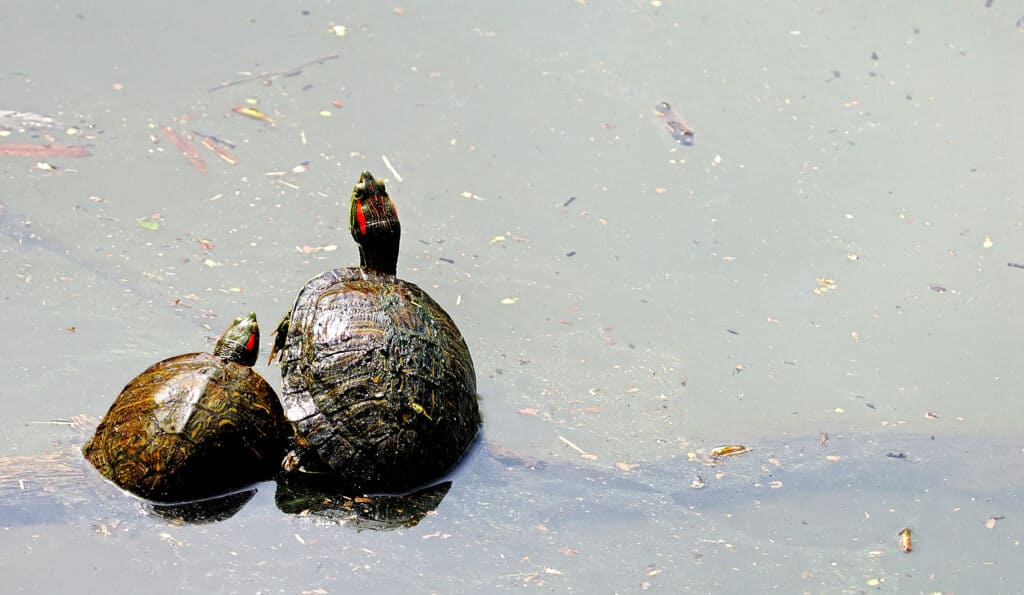Scientifically known as the Chrysemys picta, painted turtles are turtles native to North America. Their physical features include big shells, dark skin, and colored markings across their legs and necks.
Painted turtles are the most common aquatic turtles in North America. However, many people find it difficult to figure out their sexes. In this article, we’ll be examining the differences between male and female painted turtles.
Comparing a Male Painted Turtle and a Female Painted Turtle

While they may seem indistinguishable at first glance, there are a number of differences between male and female painted turtles as we are about to see in the table below.
| Male Painted Turtle | Female Painted Turtle | |
|---|---|---|
| Size | Length: 7-8 inches | Length: 8-12 inches |
| Physical appearance | Small shells, curved plastron, cloaca distant from the body, long claws, big and long tails | Large shells, flat plastrons, proximate cloaca, small tail, short claws. |
| Behavior | Males are predisposed to being territorial and often display aggression toward other turtles. | Females are more welcoming of other turtles |
| Reproductive Behavior | Males pursue and wheedle females and would proceed to mount them if the females yield | They indicate readiness to mate by scouring for nests and digging |
| Incubation Temperature | 71-78.8°f | 86-89.6°f |
| Diet in Breeding Seasons | Males need high amounts of protein for viable sperm production | Females require more calcium to help with egg production |
| Health Risks | Males face risks of kidney stone disease | Females are prone to being egg-bound. |
The Key Differences Between Male Painted Turtles and Female Painted Turtles
Male and female painted turtles have a slew of differences, majorly in their physical appearance, size, and reproductive behaviors. We shall discuss these differences in detail as they would help in distinguishing the sexes of painted turtles. Let’s delve right into it.
Male Painted Turtles vs Female Painted Turtles: Size

Male painted turtles only measure about 7-8 inches, which is smaller than the average size of the females.
©Lindaimke/Shutterstock.com
On average, female painted turtles are larger than their male counterparts. While male painted turtles only measure about 7-8 inches, female turtles measure between 8-12 inches in shell length.
We must mention that the sizes also differ across the subspecies.
Male Painted Turtles vs Female Painted Turtles: Physical Appearance

Female painted turtles have large and long shells, just enough to help them with egg production.
©Joseph M. Arseneau/Shutterstock.com
While it may be difficult to distinguish them at first glance, male and female painted turtles actually have a variety of differences in terms of their physical characteristics. While males have relatively small shells, female painted turtles have large and long shells, just enough to help them with egg production.
In addition, male painted turtles have curved plastrons, while female ones have plain flat plastrons. Male painted turtles also have their cloacae distant from their bodies, unlike the female ones who have theirs at very close range.
While female painted turtles are larger overall, male painted turtles actually have longer claws as well as wider and longer tails.
Looking out for these differences in physical appearance is perhaps the best way of ascertaining the sexes of painted turtles.
Male Painted Turtles vs Female Painted Turtles: Behavior
Male and female painted turtles also have certain differences in their behavior and interaction with others. The male painted turtles are more inclined to mark territories and display aggressiveness toward other turtles.
The females, on the other hand, are more peaceful and welcoming of other painted turtles. They are not troublesome and all they want to do is chill and build their nests.
However, both sexes are typically withdrawn and would retreat hurriedly into their habitats at the slightest provocation or threat. They can also get comfortable with humans, which is why a great number of them have been adopted as pets.
Male Painted Turtles vs Female Painted Turtles: Reproductive Behavior

Female painted turtles develop eggs, cover them with dirt after gestation, and return to their habitats while the eggs hatch.
©iStock.com/zixian
Male and female turtles also have different reproductive behaviors upon attaining sexual maturity. Like one would expect, male painted turtles display their readiness to mate by chasing the females and coaxing them as a way of soliciting consent, and upon agreement, they would get to mounting and mating.
Female painted turtles, on the other hand, dig around and look for nesting sites. When they find a suitor they are comfortable with, they would agree to mate. After which they will develop eggs, cover them with dirt after gestation, and return to their habitats while the eggs hatch.
Male Painted Turtles vs Female Painted Turtles: Incubation Temperature
One interesting fact about painted turtles is that incubation temperature actually determines their sexes. This means you can tell what sex a hatchling will turn out to be from the prevalent temperature during Incubation.
Male painted turtles are likely to emerge in temperatures between 71-78.8°F, while females would emerge in 86-89.6°F temperatures. What this means is that cooler Incubation temperatures are more likely to result in males while warmer temperatures would result in females.
This temperature-based gender development has made it a lot easier for pet lovers who hatch painted turtles themselves to determine the most probable sexes right from incubation. This means they wouldn’t even have to wait until the painted turtles grow before deciphering their sexes.
Male Painted Turtles vs Female Painted Turtles: Diet in Breeding Season

Male and female painted turtles have the same general diet, ranging from water plants to fishes, crustaceans, and insects, amongst others.
©Brian E Kushner/Shutterstock.com
Male and female painted turtles have the same general diet ranging from water plants to fishes, crustaceans, and insects amongst others. However, during the breeding season, male painted turtles require more protein for sperm production, while the females need a great supply of calcium for effective egg production.
Male Painted Turtles vs Female Painted Turtles: Health Risks
Male and female painted turtles also differ in terms of certain health risks they are prone to. While male painted turtles stand at risk of developing kidney stones, female painted turtles may face the notorious egg-bound syndrome during egg production.
However, we must mention that several other health risks are general to both male and female painted turtles. They include parasitic invasion of the intestinal tract, Hypervitaminosis A (swollen eyes, stomatitis, etc), metallic bone disease, and shell contortions.
The photo featured at the top of this post is © Jonathan Novack/Shutterstock.com
Thank you for reading! Have some feedback for us? Contact the AZ Animals editorial team.







